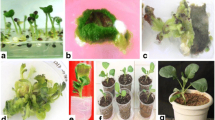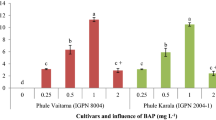Abstract
Multiplication of Moringa oleifera shoots on MS medium supplemented with 2.5 µM BAP for 3 weeks resulted in shoot vitrification which led to chlorosis, retardation of shoot formation, reduction in shoot length, necrosis of shoot tips and formation of friable calli on the base of cultured explants. Vitrification symptoms decreased when MS medium containing 2.5 µM BAP in combination with 10 µM AgNO3, 50 µM salicylic acid (SA) or 200 µM CoCl2 was used. Studying isoenzyme patterns of SOD, POX, CAT, GOT and EST indicated that moringa shoots multiplied without obvious variation in isoenzyme patterns up to 7 subcultures. Moringa shoots subjected to 14 subcultures and anti-ethylene compounds showed variation in isoenzyme patterns and were associated with the disappearance of vitrification which facilitated root formation and acclimatization. Under long term cultures, RAPD, ISSR and SSR indicated that AgNO3 was the optimal anti-ethylene substance for avoidance of vitrification in moringa but it resulted in high somaclonal variation. Application of SA decreased vitrification as well as somaclonal variation compared to CoCl2 under long term culture. Consequently, SA was recommended for moringa clonal multiplication.









Similar content being viewed by others
Abbreviations
- BAP:
-
Benzyl amino purine
- SA:
-
Salicylic acid
- EST:
-
Esterases
- GOT:
-
Glutamate oxaloactate transaminases
- SOD:
-
Superoxide dismutases
- CAT:
-
Catalases
- POX:
-
Peroxidases
- ISSR:
-
Simple Sequence Repeat
- RAPD:
-
Random Amplified Polymorphic DNA
- SSR:
-
Simple Sequence Repeat technique
References
Balen B, Krsnik-Rasol M, Zadro I, Simeon-Rudolf V (2004) Esterase activity and isoenzymes in relation to morphogenesis in Mammillaria gracillis Pfeiff. tissue culture. Acta Bot Croat 63(2):83–91
Beauchamp C, Fridovich I (1971) Superoxide dismutase: improved assays and an assay applicable to acrylamide gels. Anal Biochem 44:276–287
Beyer EM (1976) Silver ion: a potent anti-ethylene agent in cucumber and tomato. HortScience 11(3):175–196
Brewer GJ (1970) Introduction to isoenzyme techniques. Academic Press. New York
Butiuc-Keul A, Farkas A, Criste V (2016) Genetic stability assessment of in vitro plants by molecular markers. Studia Universitatis Babeş-Bolyai Biologia Lxi 1:107–114
Cassells A, Curry R (2001) Oxidative stress and physiological, epigenetic and genetic variability in plant tissue culture: implications for micro-propagators and genetic engineers. Plant Cell Tiss Org Cult 64(2–3):145–157
Chen J, Ziv M (2001) The effect of ancymidol on hyperhydricity, regeneration, starch and antioxidant enzymatic activities in liquid-cultured Narcissus. Plant Cell Rep 20:22–27
Chraibi KMB, Castelle JC, Latche A, Roustan JP, Fallot J (1992) A genotype-independent system of regeneration from cotyledons of sunflower (Helianthus annuus L.). The role of ethylene. Plant Sci 86:215–221
Cummins I, Burnet M, Edwards R (2001) Biochemical characterization of esterases active in hydrolyzing xenobiotics in wheat and competing weeds. Physiol Plant 113:477–485
Debergh PC, Harbaoui Y, Lemeur R (1981) Mass propagation of globe artichoke (Cynara scolymus): evaluation of different hypotheses to overcome vitrification with special reference to water potential. Physiol Plant 53:181–187
Devarumath RM, Nandy S, Rani V, Marimuthu S, Muraleedharan N (2002) RAPD, ISSR and RFLP finger printing as useful markers to evaluate genetic integrity of micropropagated plants of three diploid and triploid elite tea clones representing Camellia sinensis (China type) and C. assamica ssp. assamica (Assam-India type). Plant Cell Rep 21:166–173
Franck T, Kevers C, Penel C, Greppin H, Hausman JF, Gaspar T (1998) Reducing properties and markers of lipid peroxidation in normal and hyperhydrating shoots of Prunus avium L. J Plant Physiol 153:339–346
Frank T, Kavers C, Gaspar T, Dommes J, Deby C, Greimers R, Serteyn D, Deby-Dupont G (2004) Hyperhydricity of Prunus avium shoots cultured on gelrite: a controlled stress response. Plant Physiol Bioch 42:519–527
Ganesana SK, Singh R, Choudhury DR, Bharadwajb J, Guptac V, Singoded A (2014) Genetic diversity and population structure study of drumstick (Moringa oleifera Lam.) using morphological and SSR markers. Ind Crop Prod 60:316–325
Gaspar T (1991) Vitrification in micropropagation. In: Bajaj Y.P.S. (ed) Biotechnology in agriculture and forestry: High-Tech and Micropropagation I, vol 17. Springer, Berlin, pp 117–126
Gaspar T, Penel C, Castillo FJ, Greppin H (1985) A two-step control of basic and acidic peroxidases and its significance for growth and development. Physiol Plant 64:418–423
Gaspar T, Kevers C, Franck T, Bisbis B, Billard JP, Huault C, Le Dily F, Petit-Paly G, Rideau M, Penel C, Crèvecoeur M, Greppin H (1995) Paradoxical results in the analysis of hyperhydric tissues considered as being under stress: questions for a debate. Bulg J Plant Physiol 21(2–3):80–97
Hassanein AM (2004) Effect of relatively high concentration of mannitol and sodium chloride on regeneration and gene expression of stress tolerant (Alhagi graecorum) and stress sensitive (Lycopersicon esculentum L) plant species. Bulg J Plant Physiol 30:19–36
Hassanein AM, Ahmed AM, Abdel-Hafez AII, Soltan DM (1999) Isoenzymes expression during root and shoot organogenesis of Solanum nigrum. Biol Plant 42:341–347
Hassanein AM, Ibraheim IA, Galal AA, Salem JMM (2005) Micro-propagation factors essential for mass production of synthetic seeds in banana. J Plant Biotech 7:175–181
Hassanein AM, Ahmed AM, Soltan DM (2008) Study of somaclonal variation and gene expression as influenced by long term culture in sorghum. Curr Opin Biotech 4:13–20
Isah T (2015) Adjustments to in vitro culture conditions and associated anomalies in plants. Acta Biol Cracov Ser Bot 57(2):9–28
Jain SM, Brar DS, Ahloowalia BS (1998) Somaclonal variation and induced mutations in crop improvement. Kluwer, London
Joshi P, Dhawan V (2007) Assessment of genetic fidelity of micropropagated Swertia chirayita plantlets by ISSR marker assay. Biol Plant 51:22–26
Kaeppler SM, Kaeppler HF, Rhee Y (2000) Epigenetic aspects of somaclonal variation in plants. Plant Mol Biol 43:179–188
Kei-Ichiro U, Susan C, Kalidas S (1998) Reduced hyperhydricity and enhanced growth of tissue culture-generated raspberry (Rubus sp.) clonal lines by Pseudomonas sp. isolated from oregano. Process Biochem 33(4):441–445
Kharrazi M, Nemati H, Tehranifar A, Bagheri A, Sharifi A (2011) In vitro culture of carnation (Dianthus caryophyllus L.) focusing on the problem of vitrification. J Biol Environ Sci 5(13):1–6
Kumar V, Prabha C (2016) In vitro study of somaclonal variation in Chlorophytum borivilianum. Int J Curr Microbiol Appl Sci 5(12):376–382
Larkin PJ, Scowcroft SC (1981) Somaclonal variation: a novel source of variability from cell culture for plant improvement. Theor Appl Genet 60:197–214
Lau OL, Yang SF (1976) Inhibition of ethylene production by cobaltous ion. Plant Physiol 58(1):114–117
Machado MP, da Silva ALL, Biasi LA, Deschamps C, Filho JCB, Zanette F (2014) Influence of calcium content of tissue on hyperhydricity and shoot tip necrosis of in vitro regenerated shoots of Lavandula angustifolia Mill. Braz Arch Biol Tech 57(5):636–643
Mirza F, Uliaie ED, Hagh AB (2015) Stimulation effect of AgNO3 and CoCl2 as ethylene inhibitors on in vitro organogenesis of sunflower (Helianthus annuus L.). Yyu J Agr Sci 25(2):113–118
Mittler R (2002) Oxidative stress, antioxidants and stress tolerance. Trends Plant Sci 7:405–410
Murashige T, Skoog F (1962) A revised medium for rapid growth and bioassay with tobacco tissue culture. Physiol Plant 15:473–479
Nagaoka T, Ogihara Y (1997) Applicability of inter-simple sequence repeat polymorphisms in wheat for use as DNA markers in comparison to RFLP and RAPD markers. Theor Appl Gen 94:597–602
Pimenta MR, Ribeiro CB, Soares CQG, Mendes GC, Braga VF, Reis LB, Otoni WC, Resende CF, Viccini LF, Peixoto PHP (2013) Ethylene synthesis inhibition effects on oxidative stress and in vitro conservation of Lippia filifolia (Verbenaceae). Braz J Biol 73(3):617–621
Porebski S, Bailely LG, Baum BR (1997) Modification of a CTAB DNA extraction protocol for plants containing high polysaccharides and polyphenol component. Plant Mol Biol Rep 15:8–15
Ramanjulu S, Veeranjaneyulu K, Sudhakar C (1994) Short-term shifts in nitrogen metabolism in mulberry (Morus alba L.) under salt shock. Phytochem 37:991–995
Rojas-Martínez L, Visser RGF, de Klerk GJ (2010) The hyperhydricity syndrome: water logging of plant tissues as a major cause. Propag Ornam Plants 10(4):169–175
Saez PL, Bravo LA, Latsague MI, Sánchez ME, Ríos DG (2012) Increased light intensity during in vitro culture improves water loss control and photosynthetic performance of Castanea sativa grown in ventilated vessels. Sci Hortic 138:7–16
Saha S, Adhikari S, Dey T, Ghosh P (2016) RAPD and ISSR based evaluation of genetic stability of micropropagated plantlets of Morus alba L. variety S-1. Meta Gene 7:7–15
Salem JM (2016) In vitro propagation of Moringa oleifera L. under salinity and ventilation conditions. Genet Plant Physiol 6(1–2):54–64
Sarroppulou V, Dimassi-Theriou K, Therios I (2016) Effect of the ethylene inhibitors silver nitrate, silver sulfate, and cobalt chloride on micropropagation and biochemical parameters in the cherry rootstocks CAB-6P and Gisela 6. Turk J Biol 40:670–683
Scandalios JG (1993) Oxygen stress and superoxide dismutase. Plant Physiol 101:7–12
Senior ML, Murbhy GB, Goodman MM, Stuber CW (1998) Utility of SSRs for detecting genetic similarities and relationships in maize using agarose gel system. Crop Sci 38:1088–1098
Siegel BZ, Galston AW (1967) The peroxidase of Pisum sativum. Plant Physiol 42:221–226
Sneath PHA, Sokal RR (1973) Numerical taxonomy. Freeman, San Francisco
Snedecor GW, Cochran WG (1980) Statistical methods, 7th edn. Iowa State University Press, Ames
Tamás L, Huttová J, Mistrík I, Šimonovičová M, Široká B (2005) Aluminium induced esterase activity and isozyme pattern in barley root tip. Plant Soil Environ 51(5):220–225
Tamimi SM (2015) Effects of ethylene inhibitors, silver nitrate (AgNO3), cobalt chloride (CoCl2) and aminooxyacetic acid (AOA), on in vitro shoot induction and rooting of banana (Musa acuminata L.). Afr J Biotech 14(32):2510–2516
Tripathy SK, Panda A, Nayak PK, Dash S, Lenka D, Mishra DR, Kar RK, Senapati N, Dash GB (2016) Somaclonal variation for genetic improvement in grasspea (Lathyrus sativus L.). Legume Res 39(3):329–335
Wang KLC, LI H, Ecker JR (2002) Ethylene biosynthesis and signaling networks. Plant Cell 14(1):131–151
Wang ZQ, Yuan YZ, Ou JQ, Lin QH, Zhang CF (2007) Glutamine synthetase and glutamate dehydrogenase contribute differentially to proline accumulation in leaves of wheat (Triticum aestivum) seedlings exposed to different salinity. J Plant Physiol 164:695–701
Woodbury W, Spencer AK, Stahmann MA (1971) An improved procedure using ferricyanide for detecting catalase isoenzymes. Anal Bioch 44:301–305
Zhang RH, Guo SR, Fan HF.. (2006) Effects of exogenous Spdon NO3–-N, NH4 +-N contents and nitrate reductase activity of salt stressed leaves and roots of cucumber seedlings. J Wuhan Bot Res 24:381–384
Zietkiewicz E, Rafalski A, Labuda D (1994) Genome fingerprinting by simple sequence repeat (SSR)-anchored polymerase chain reaction amplification. Genomics 20:176–183
Acknowledgements
The authors would like to thank Prof. Moneim Shamloul of Fraunhofer USA Center for Molecular Biotechnology, Newark, DE, USA for English language revision.
Author information
Authors and Affiliations
Contributions
AMH proposed the idea and the experimental design, revised the manuscript and acted as a corresponding author; JMS participated in the experimental design, interpretation and acquisition the data; FAF participated in the experimental design and drafted the manuscript; AE performed the measurements, drafted the manuscript and performed the statistical analysis. All authors read and approved the final manuscript.
Corresponding author
Ethics declarations
Conflict of interest
The authors whose names are listed in this manuscript certify that they have NO affiliations with or involvement in any organization or entity with any financial interest in the subject matter or materials discussed in this manuscript.
Additional information
Communicated by Sergio J. Ochatt.
Rights and permissions
About this article
Cite this article
Hassanein, A.M., Salem, J.M., Faheed, F.A. et al. Effect of anti-ethylene compounds on isoenzyme patterns and genome stability during long term culture of Moringa oleifera . Plant Cell Tiss Organ Cult 132, 201–212 (2018). https://doi.org/10.1007/s11240-017-1326-0
Received:
Accepted:
Published:
Issue Date:
DOI: https://doi.org/10.1007/s11240-017-1326-0




